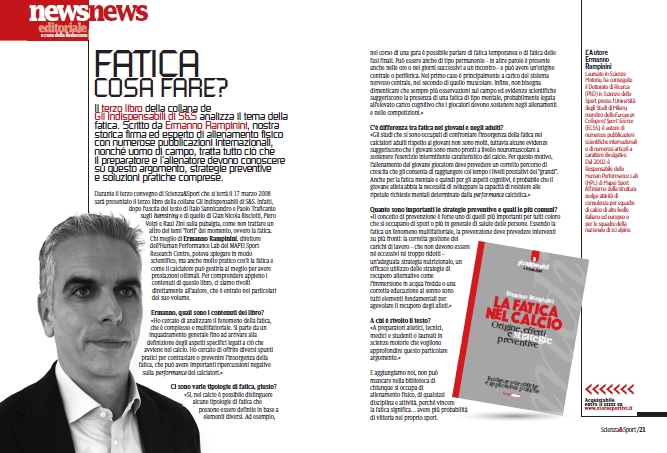The third book of the S&S Gli Indispensabili series will be presented at the third Scienza&Sport conference on Saturday 17th March 2018. After the release of the text by Italo Sannicandro and Paolo Traficante on hamstring and that of Gian Nicola Bisciotti, Piero Volpi and Raul Zini on pubalgia, how not to treat another of the strong themes of the moment, fatigue. In “Fatigue in football: origin, effects and preventive strategies” the historical signature of the scientific magazine and physical training expert with numerous international publications, as well as field man, Ermanno Rampinini deals with everything that the trainer and coach must know about this topic, preventive strategies and practical solutions included. The director of Mapei Sport Research Center Human Performance Lab, explains in a scientific but also very practical way, what fatigue is and how the footballer can manage it to the best for optimal performance.

Ermanno, what are the contents of the volume?
«I tried to analyze the phenomenon of fatigue, which is complex and multifactorial. It starts from a general framework up to the definition of specific aspects related to what happens in football. I tried to offer various practical ideas to counter or prevent the onset of fatigue, which can have important negative repercussions on the players’ performance».
There are various types of fatigue, right?
«Yes, in football it is possible to distinguish some types of fatigue that can be defined on the basis of different elements. For example, during a race it is possible to talk about temporary fatigue or fatigue of the final phases. It can also be permanent – in other words it is also present in the hours or days after a match – and it can have a central or peripheral origin. In the first case it is mainly dependent on the central nervous system, in the second on the muscular system. Finally, we must not forget that more and more observations on the field and scientific evidence suggest the presence of mental fatigue, probably linked to the high cognitive load that the players have to support in training and competitions».
Is there a difference between fatigue in young people and adults?
«There are not many studies comparing the onset of fatigue in adult football players compared to young people, but some evidence suggests that young people are less ready at the neuromuscular level to support the characteristic intermittent exercise of calcium. For this reason, the training of the young player must provide for a correct growth path that will allow him to achieve the “big” levels of performance over time. Also for mental fatigue and therefore for cognitive aspects, it is likely that the young athlete needs to develop the ability to resist the repeated mental demands determined by football performance».
How important are preventive strategies and which are the most common?
«The concept of prevention is perhaps one of the most important for all those involved in sports or more generally in the health of people. Since fatigue is a multifactorial phenomenon, prevention must include interventions on several fronts: the correct management of workloads – which must not be excessive or too much reduced – an adequate nutritional strategy, an effective use of alternative recovery strategies such as cold water immersion or proper sleep education are all fundamental elements to facilitate athletes recovery».
Who is the text addressed to?
«To athletic trainers, technicians, doctors and students or graduates in physical education who want to deepen this particular topic».
And we add, this book can not miss in the library of anyone involved in physical training, any discipline and activity, because winning fatigue means… having more chances of winning in your sport.